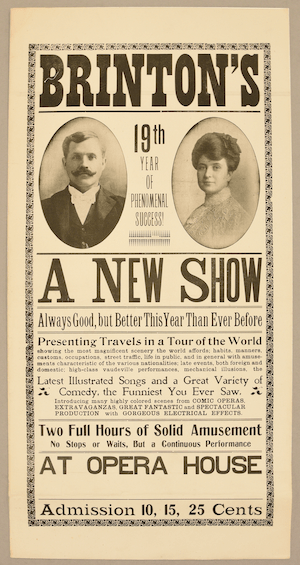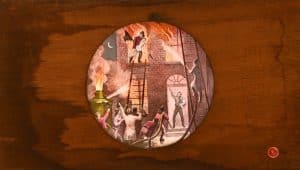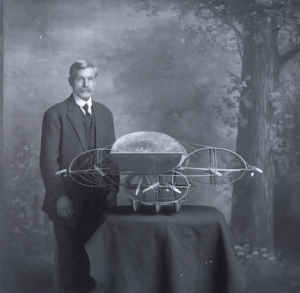Currently on exhibit in the Main Library Gallery is Brinton’s Famous Moving Pictures from The Brinton Entertainment Company Papers (MsC1000) held in Special Collections at the University of Iowa Libraries, with additional material from the Keith/Albee Vaudeville Theatre Collection (MsC0356), and other materials from Special Collections and the Iowa Women’s Archives.
The exhibition features artifacts, photos, and films from the late 19th and early 20th centuries – a magical era in entertainment history that observed the intersection of live theatre, radio, and film.
The materials are part of a collection preserved for many years by Michael Zahs, subject of the new documentary film, Saving Brinton. The University of Iowa Libraries began the process of accepting Zahs’ generous donation of the Brinton Collection in 2014.
The collection contains films, slides, projectors, papers, and other documents from the life and career of William Franklin Brinton of Washington, IA. Frank Brinton was an itinerant showman who ran the Brinton Entertainment Co. of Washington, Iowa. From 1895 to 1909, Brinton and associates traveled throughout the region from Texas to Minnesota showing slides and films in combination with live entertainment for populations who, in many cases, had never before seen such sights.
 THE BRINTON STORY
THE BRINTON STORY
Brinton was born in Washington County, Iowa in 1865. He initially made a living farming, inventing, and travelling. After numerous trips to the Holy Land, he perfected a style of presentation, illustrating his travelogue lectures with magic lantern slide views of the areas he had visited.
Eventually, Brinton established the Brinton Entertainment Co. of Washington, Iowa. Throughout the 1890s and into the 1900s, Brinton and his wife, Indiana, produced touring shows that appeared at the region’s opera houses, as well as in tents and other spaces. The shows featured magic lantern slides, lighting effects, and some of the earliest commercially-available films.
Brinton was an eccentric and energetic individual, and the collection not only preserves some of the earliest commercially available film, but also contains material related to Brinton’s experimental interests, such as his passion for designing flying machines long before human flight became a reality.
Indiana Brinton was an important partner in her husband’s entertainment ventures. She travelled with him and did a large amount of the organizational work necessary to mount a successful touring production. In her Iowa hometown of Washington, she was also known as a very glamorous woman, living an eccentric lifestyle in keeping with her husband’s forward-looking ideas. She outlived Frank by 36 years and spent much of her time travelling.
Brinton purchased films from catalogs produced by the leading companies of the day, including Pathé, Edison, and Méliès. His annotations can be found throughout. Brinton selected many of the films that are now part of the Brinton Collection from these catalogs, which years later served as the primary means of identifying specific titles.
During the first years of the 20th century, Brinton became the manager of the Graham Opera House in Washington, Iowa, which first opened in 1893 and began showing films in 1897. It is still an active movie theater today and was recently declared the longest continually operating cinema in the world.
Under Brinton’s management, the Graham Opera House showed a variety of films, as well as live performances, and, as the United States became involved in World War I, the venue also hosted Red Cross events and showed war films.
As WWI came to an end in 1918, Brinton became ill and signed over management of the Opera House to George Bickford and Harold Holmes, moving his films, projector, and other entertainment material to his basement. He died shortly thereafter, in 1919.
One hundred years later, Frank and Indiana Brinton’s legacy in Washington and the State of Iowa lives on through the efforts of Michael Zahs, who rescued their collection from the brink of destruction.
MAGIC LANTERNS
 Before the advent of film, audiences became accustomed to the sight of Magic Lantern slides—images that were projected through glass. There were many different forms. Some were static; some projected images in a sequence to depict a story; some had notes and words to lead a sing-along; others had intricate moving parts giving the illusion of motion. These magic lantern slides were encased in a wood frame to provide protection for the glass as they were transported and moved quickly through projectors during a show.
Before the advent of film, audiences became accustomed to the sight of Magic Lantern slides—images that were projected through glass. There were many different forms. Some were static; some projected images in a sequence to depict a story; some had notes and words to lead a sing-along; others had intricate moving parts giving the illusion of motion. These magic lantern slides were encased in a wood frame to provide protection for the glass as they were transported and moved quickly through projectors during a show.
FLYING MACHINES
 Frank Brinton made a business of bringing dreams to life with his films and shows, but his personal dream was even more ambitious: he wanted to fly. In the 1890s, long before the Wright Brothers’ flights made history, Brinton, like many others, labored to perfect a machine that could reliably take flight and operate under human control.
Frank Brinton made a business of bringing dreams to life with his films and shows, but his personal dream was even more ambitious: he wanted to fly. In the 1890s, long before the Wright Brothers’ flights made history, Brinton, like many others, labored to perfect a machine that could reliably take flight and operate under human control.
Brinton refined his ideas over several years and made many different models to test his theories. Claims were made that Brinton flew these machines as part of his entertainment shows—it is likely that if he featured his models, he constructed some type of apparatus to suspend them. In 1899, there was to have been a public event in Washington, Iowa promising an ascent. When it was cancelled, the assembled throngs rioted to express their disappointment, or perhaps glee. It seems as though Brinton never achieved flight… that we know of.
To view some of the films featured in the exhibition, visit the Brinton Collection website.
EXHIBIT CREDITS
EXHIBITION CURATION
Greg Prickman, Head, Special Collections, UI Libraries
Elizabeth Riordan, Graduate Research Assistant, Special Collections, UI Libraries
EXHIBITION PREPARATION & INSTALLATION
Giselle Simón & Bill Voss, UI Libraries Conservation Lab
MULTIMEDIA PREPARATION & INSTALLATION
Mark Mueller, Comm Infrastructure Engineer, Office of Teaching, Learning & Technology
Will Brown, Desktop Support Analyst, ITS
DESIGN
Kalmia Strong, UI Libraries Creative Coordinator
COORDINATION, WEB SITE, PUBLICITY & OTHER ASSISTANCE
Leah Morlan, Program Coordinator, Digital Scholarship & Publishing Studio, UI Libraries
Connor Hood, Public Engagement Specialist, Digital Scholarship & Publishing Studio, UI Libraries
Ken Clinkenbeard, UI Libraries Web Services Specialist
Jennifer Masada, UI Libraries Strategic Communications Manager
Colleen Theisen, Special Collections Department, UI Libraries
FINANCIAL SUPPORT FOR THE EXHIBITION
Friends of the UI Libraries
Special thanks to Michael Zahs, donor of the Brinton Entertainment Company Papers, and to Andrew Sherburne, Tommy Haines, and John Richard, makers of the film Saving Brinton
